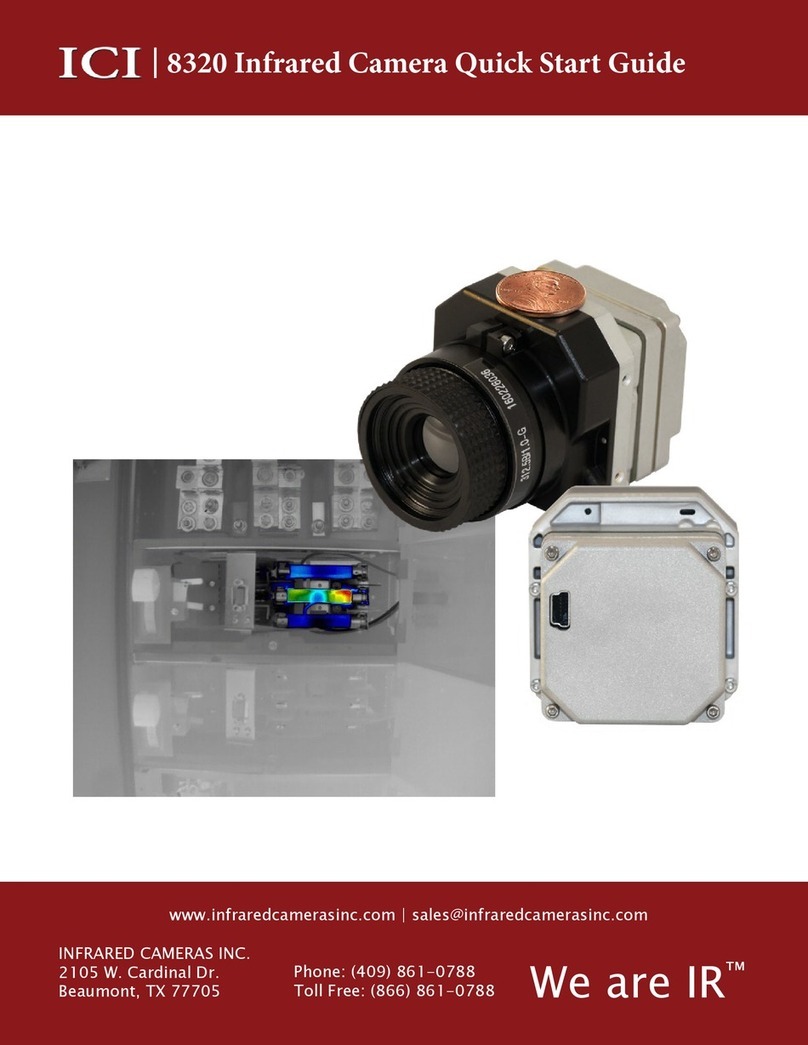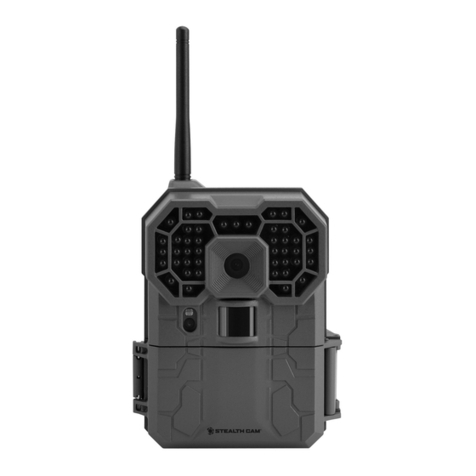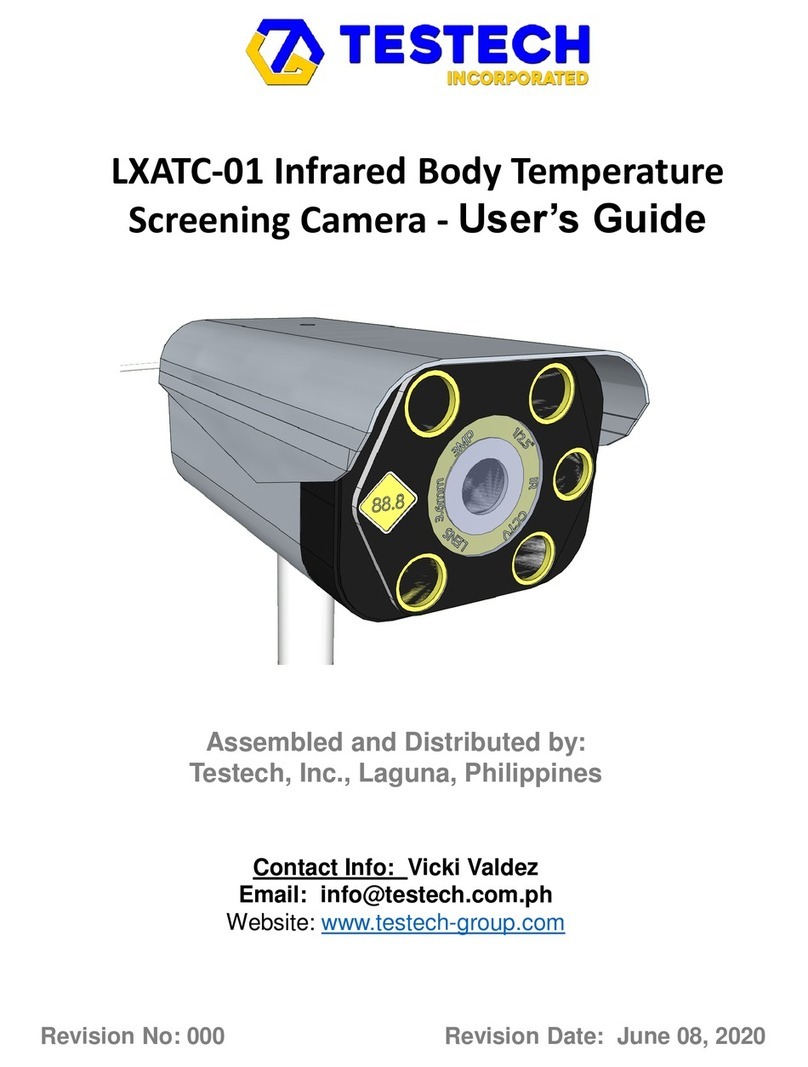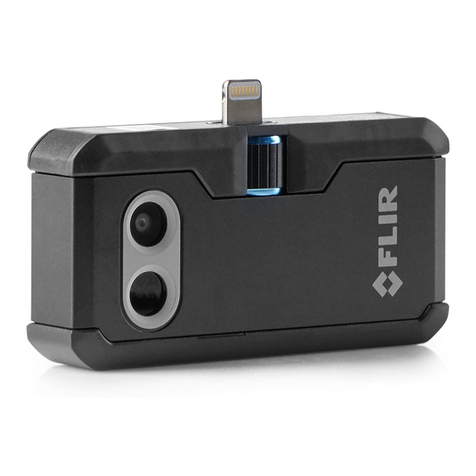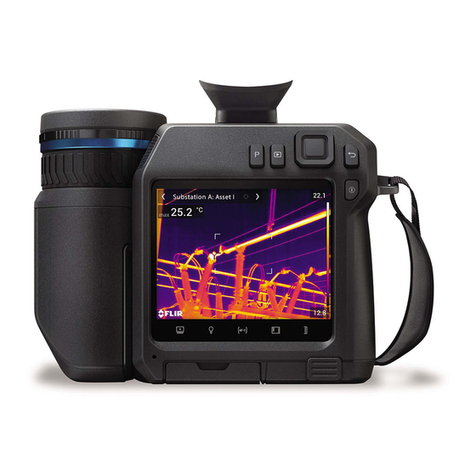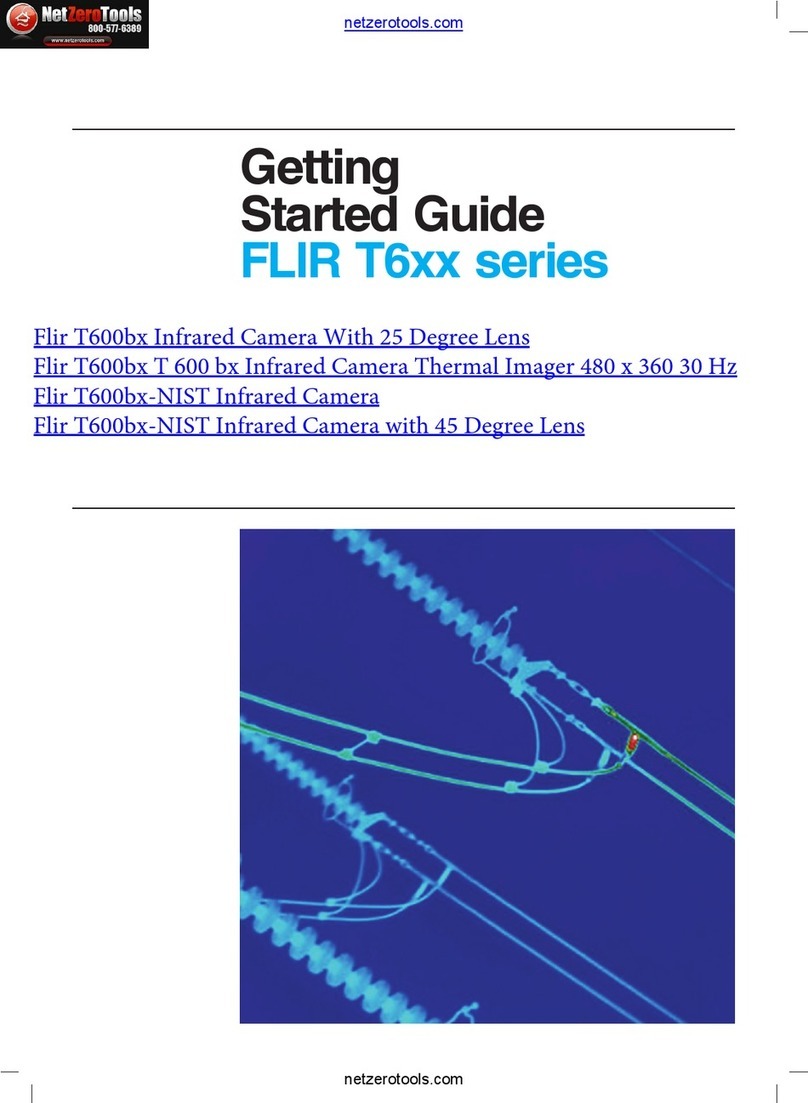Finmeccanica DRS Technologies Tamarisk 320 User manual

Document No: 1012820
Revision: D
Tamarisk
TamariskTamarisk
Tamarisk
®320
320320
320
17 µm 320x240 Long Wave Infrared Camera
Elec rical In erface Con rol Documen

Tamarisk
®320
Electrical ICD
©
Copyright 2012, DRS TECHN L GIES, Inc.- All rights reserved.
13532 N. Central Expressway
Dallas, TX 75243
877.377.4783
www.drsinfrared.com
The contents of this document may not be reproduced in whole or in part without the written
consent of the copyright owner.
N TICE
N TICEN TICE
N TICE
ALL STATEMENTS, INF RMATI N, AND REC MMENDATI NS IN THIS MANUAL ARE BELIEVED T BE ACCURATE BUT ARE
PRESENTED WITH UT WARRANTY F ANY KIND. N TWITHSTANDING ANY THER WARRANTY HEREIN, ALL D CUMENT FILES
AND S FTWARE ARE PR VIDED “AS IS” WITH ALL FAULTS. DRS DISCLAIMS ALL WARRANTIES, EXPRESSED R IMPLIED,
INCLUDING, WITH UT LIMITATI N, TH SE F MERCHANTABILITY, FITNESS F R A PARTICULAR PURP SE AND
N NINFRINGEMENT R ARISING FR M A C URSE F DEALING, USAGE, R TRADE PRACTICE.
IN N EVENT SHALL DRS BE LIABLE F R ANY INDIRECT, SPECIAL, C NSEQUENTIAL, R INCIDENTAL DAMAGES, INCLUDING,
WITH UT LIMITATI N, L ST PR FITS R L SS R DAMAGE T DATA ARISING UT F THE USE R INABILITY T USE THIS
MANUAL, EVEN IF DRS HAS BEEN ADVISED F THE P SSIBILITY F SUCH DAMAGES.
Rev History
Revision Number Release Date Description
A 01/24/2013
Initial Release
B 9/5/2013 Derived from Tamarisk 640
version
C 06/09/2014 Prepared for Public Release
D 2/15/2015 Updated PDVO Timing
Camera Link
®
is a registered trademark of the Automated Imaging Association.

Tamarisk
®320
Electrical ICD
2
TA B L E O F CO N T E N T S
Table of Contents 2
Acronyms and Abbreviations 3
Reference Documentation 4
Safety Instructions 5
1 Scope 6
2 Electrical Interfaces 7
2.1 Base Configuration Electrical Interface ....................................................................... 7
2.2 Base Configuration Input Power Specification............................................................. 9
2.3 Base + Feature Board Configuration Electrical Interface............................................10
2.4 Base + Feature Board Configuration Input Power Specification .................................12
2.5 UART Interface ..........................................................................................................13
2.6 Shutter Control...........................................................................................................13
2.7 GENLOCK .................................................................................................................14
2.8 USB_DETECT ...........................................................................................................14
3 Interfaces and Timing 15
3.1 LVDS Interface...........................................................................................................15
3.2 PARALLEL DIGITAL VIDEO INTERFACE .................................................................18
3.3 Analog Video Interface...............................................................................................23
3.4 USB Interface(base + feature only) ............................................................................24
3.5 RS-232 Interface(base + feature only) .......................................................................24
3.6 Shutter Interface ........................................................................................................24
4 Electrical Connectors 25

Tamarisk
®320
Electrical ICD
3
AC R O N Y M S A N D AB B R E V I A T I O N S
Abbreviation
Description Abbreviation
Description
°C Celsius mm millimeter
°F Fahrenheit ms milliseconds
AGC automatic gain control MSB Most Significant Bit
BPR bad pixel replacement MT Maximum Transfer nit
CCA circuit card assembly MWIR Mid-wave infrared
CL center line NETD noise equivalent temperature difference
COMM communication NTSC National Television System Committee
CSC Computer Software Component N C non-uniformity correction
CSCI Computer Software Configuration Item NVTHERM Night Vision Thermal Analysis Tool
CS Computer Software nit OEM original equipment manufacturer
dB decibels OLA Optical Lens Adapter
DSP digital signal processor P probability
ESD electrostatic discharge POL polarity
E-Zoom electronic zoom psi pound per square inch
FOV field of view Rev revision
FPA Focal Plane Array ROI region of interest
ft feet SC split configuration
G gravitational force SWIR Short-wave infrared
g gram TBD To Be Determined
G I graphical user interface TCR Temperature coefficient of resistance
H height TIM Thermal Imaging Module
HFOV horizontal field of view ART niversal Asynchronous Receiver Transmitter
I/O input/output AV unmanned aerial vehicle
ICD Interface Control Document FPA n-cooled Focal Plane Array
ICE Image Contrast Enhancement SB niversal Serial Bus
ID identification V Vertical or Voltage
IR infrared VDC volts direct current
IRS Interface Requirements Specification VGA video graphics array
km kilometer VOx Vanadium Oxide
LR lower right W width or Watt
LWIR long-wave infrared μm micron (micrometer)

Tamarisk
®320
Electrical ICD
4
RE F E R E N C E DO C U M E N T A T I O N
The following documents form part of this specification. In the event of a conflict between
documents referenced herein and the contents of this specification, the contents of this specification
shall be considered a superseding requirement.
Document No: 1012593 Tamarisk
®320
User Manual
Document No: 1012819 Tamarisk
®320
Software Interface Control Document
Document No: 1012821 Tamarisk
®320
Camera Control Software User Guide
Document No: 1003727 Tamarisk
®
320 Mechanical Interface Control Document

Tamarisk
®320
Electrical ICD
5
SA F E T Y IN S T R U C T I O N S
NOTIFICATIONS: CAUTION, WARNING AND NOTE
The following is a list of notifications and their accompanying symbol that may be found throught
this document to alert the reader to potential risks and to minimize the potential for personal injury
and or damage to the product. When a notification is present, it is important that the user review and
understand all statements related to the notification before proceeding. If questions arise, please
contact your authorized dealler or DRS Technologies.
Notifications are preceeded by a symbol and followed by highlighted text. Three types of
notifications are typically used and are defined below:
CAUTION
A caution is a procedure, practice, or condition that, if not strictly followed, may
result in personal injury or damage to the equipment that may impede product
performance.
WARNING
A warning is intended to alert the user to the presence of potentially harmful
circumstances and provide precautionary guidance for mitigating risk of personal
injury and or damage to the product.
NOTE
A note is a statement that clarifies or is used to emphasize important information.
1. Read all instructions
2. Keep these instructions for future reference.
3. Follow all instructions
4. Heed all warnings.
5. Do not submerge this apparatus in liquid of any kind.
6. Clean per recommended instructions using dry non-abrasive cloth.
7. Do not install near any sources of intense heat such as radiators, furnaces, stoves
or other apparatus that regulary produce excessive heat.
8. Refer all servicing to qualified service personnel

Tamarisk
®320
Electrical ICD
6
1
SC O P E
This document describes the electrical interfaces for the Tamarisk
®320
line of
17µm, LWIR OEM
Modules and unless otherwise noted, this document describes all configurations of the module.
Software and mechanical support documentation are described in separate documents See Reference
Documentation for a complete listing.
The Tamarisk
®320
product name identifies a family of long-wave infrared video cameras with a 17um
pixel pitch 320 x 240 sensor array and comes in two basic configurations (Base and Base + Feature
Board). Refer to the Tamarisk
®320
Users Manual for more information.
In this section, the electrical interfaces for the Base configuration and Base + Feature Board
configuration are described.
Figure 1: Tamarisk
®320
Base Configuration
The Base configuration provides digital outputs in the form of 8-bit, 14-bit or “YUV Superframe”
parallel digital video (LVCMOS UART), 8-bit, 14-bit, 24-bit RGB or “YUV Superframe” Camera
Link® video, and supports shutter status through a 60-pin connector. Advantages of the Base
configuration include parallel digital video output, reduced size, weight and power requirements.
Figure 2: Tamarisk
®320
Base + Feature Board Configuration
The Base + Feature Board configuration supports RS232 and USB 2.0 serial control, NTSC and PAL
analog video outputs, digital video output via Camera Link® and accepts a range of input power
voltages from 5-18V through a single 30-pin connector. Advantages of this configuration is that it
provides analog video output, as well as full RS232 or USB 2.0 communication.
The recommended screw to secure the feature board is a .060-80 X .125 pan head screw.
Processor Board
60-pin Connector
Lens
Lens Mount
Retaining Ring
Camera
Housing
Camera
Housing
Feature Board
30
-
pin Connector
Lens
Lens Mount
Retaining Ring

Tamarisk
®320
Electrical ICD
7
2
EL E C T R I C A L IN T E R F A C E S
2.1 BASE CONFIGURATION ELECTRICAL INTERFACE
This configuration has no Feature board; the electrical interface is through a 60-pin connector located
on the Processor board see Figure 1: Tamarisk
®320
Base Configuration for location. A Board layout
is provided below. For more dimesional information, please refer to Document No: 1003727
Tamarisk
®320
Mechanical Interface Control Document. The Tamarisk Camera Link
®1
video, digital
video, LVCMOS UART interface, shutter status are supported. See the electrical interface pin-out
listed in Table 1.
Figure 3: Processor Board with Connector Location and Dimensions
Table 1: Electrical Interface Pin-Out for Base Configuration
Pin Signal
Name
Func-
tion Description Pin Signal Name Func-
tion Description
J2.1
J2.3
J2.5
J2.7
Ground Power Primary ground return for
module power.
J2.2
J2.4
J2.6
J2.8
VIN Power
Primary voltage supply
for the camera/module
(3-5.5V)
J2.9
J2.11
Reserved
Reserved NA No Connection J2.10 NC NA NA
1
Camera Link® serial control (LVDS_RDp/LVDS_RDn, LVDS_TDp/LVDS_TDn) are NOT supported in any
configuration, serial control is always provided with the UART control for base configuration.
60-Pin Connector –J2
Pin 1
Pin 2

Tamarisk
®320
Electrical ICD
8
Pin Signal
Name
Func-
tion Description Pin Signal Name Func-
tion Description
J2.13
J2.15
Reserved
Reserved NA No Connection J2.12 USB_DETECT Input
USB Control signal
detection. It is
recommended that If
communicating to the
camera via a USB to
serial converter, tie this
pin low. If
communicating to the
camera via RS232 or
another UART, tie this
pin high.
J2.17
J2.19
LVDS_D3p
LVDS_D3n
Output
2
LVDS Video output Data 3 J2.14 UART_TX Output UART Control Output
J2.21
J2.23
LVDS_D2p
LVDS_D2n Output LVDS Video output Data 2 J2.16 UART_RX Input UART Control Input
J2.25
J2.27
LVDS_D1p
LVDS_D1n Output LVDS Video output Data 1 J2.18 Reserved NA No Connection
J2.29
J2.31
LVDS_D0p
LVDS_D0n Output LVDS Video output Data 0 J2.20 Reserved NA No Connection
J2.33
J2.35
LVDS_CLK
p
LVDS_CLK
n
Output LVDS Video Data output
Clock J2.22 Reserved NA No Connection
J2.37 BDSI_D11 Output Parallel Digital Data
Output J2.24 SHUTTER_DR
IVE Output
High when the
shutter is driven
J2.39 BDSI_D10 Output Parallel Digital Data
Output J2.26 SHUTTER_EV
ENT Output
High during a
calibration event
J2.41 BDSI_D9 Output Parallel Digital Data
Output J2.28 Reserved NA No Connection
J2.43 BDSI_D8 Output Parallel Digital Data
Output J2.30 Reserved NA No Connection
J2.45 BDSI_D7 Output Parallel Digital Data
Output J2.32 Reserved NA No Connection
J2.47 BDSI_D6 Output Parallel Digital Data
Output J2.34 Reserved NA No Connection
J2.49 BDSI_D5 Output Parallel Digital Data
Output J2.36 Reserved NA No Connection
J2.51 BDSI_D4 Output Parallel Digital Data
Output J2.38 GENLOCK Input/
Output
Video Genlock signal
master or slave. If not
used, leave floating
J2.53 BDSI_D3 Output Parallel Digital Data
Output J2.40 BDSI_PCLK Output Parallel Digital Video
Clock
J2.55 BDSI_D2 Output Parallel Digital Data
Output J2.42 BDSI_LSYNC Output
Parallel Digital Video
Line Sync (Active
High)
2
Unused outputs can be no connects
“No connection” should be left floating.

Tamarisk
®320
Electrical ICD
9
Pin Signal
Name
Func-
tion Description Pin Signal Name Func-
tion Description
J2.57 BDSI_D1 Output Parallel Digital Data
Output J2.44 BDSI_FSYNC Output
Parallel Digital Video
Frame Sync (Active
High)
J2.59 BDSI_D0 Output Parallel Digital Data
Output J2.46 BDSI_D13 Output Parallel Digital Video
Data Output
J2
Figure 4: 60-pin Connector – J2
J2.48 BDSI_D12 Output Parallel Digital Video
Data Output
J2.50
J2.52
J2.54
VCC_IO Power
Output 1.8V I/O Supply Output
J2.56
J2.58
J2.60
Ground Power Ground
Figure 3 provides the board, mounting hole, and connector (J2) dimensions. All dimensions are in
mils and all dimensions are show at the center of the connector or mounting holes (please see
mechanical ICD listed in reference documentation for all up to date dimensions and drawings).
2.2 BASE CONFIGURATION INPUT POWER SPECIFICATION
The primary voltage input (VIN) for this configuration requires the input voltage to be within the
range from 3.0 to 5.5VDC. There are many readily available commercial power supplies power
adapters, and or batteries/battery packs meeting this voltage range with the current requirements
outlined in Table 2.
Table 2: Base Configuration Input Power Specification
Parameter Description Min Typ Max Units
VIN Input Voltage 3.0 5.0 5.5 V
Icc Input Current (VIN=5.0) 200 260 mA
Icc with Shutter active* Input Current RMS during transition
(VIN=5.0) 400 650 mA
V
OH
LVDX_XXX
V
OH
High Level Output (2.5V output), I
OH
= -1mA
2.0
V
V
OL
LVDS_XXX
V
OL
Low Level Output (2.5V output), I
OL
= -1mA
0.4
V
V
OH
UART_TX
V
OH
High Level Output (1.8V output) 1.35
V
V
OL
UART_TX
V
OL
Low Level Output (1.8V output) 0.45 V
V
IH
UART_RX, GENLOCK
V
IH
High Level Input (1.8V input) 1.17 2.25 V
V
IL
UART_RX, GENLOCK
V
IL
Low Level Input (1.8V input -0.3 0.63 V
V
OH
BDSI_xx, USB_DETECT, V
OH
High Level Output (1.8V output), I
OH
= -2mA 1.35 V

Tamarisk
®320
Electrical ICD
10
Parameter Description Min Typ Max Units
SHUTTER_DRIVE,
SHUTTER_EVENT,
WE_TEST#, GENLOCK
V
OL
BDSI_xx, USB_DETECT,
SHUTTER_DRIVE,
SHUTTER_EVENT,
WE_TEST#, GENLOCK
V
OL
Low Level Output (1.8V output), I
OL
= -2mA 0.45 V
*The shutter is typically active for 100 mS closing and 100ms opening.
NOTE
Shutter current demand is instantaneous; care should be taken to provide
bypass capacitance to prevent voltage regulator sag.
The module also provides a 1.8V output that can be used to supply some circuitry on the feature
board for the system. This supply is used to drive all 1.8V outputs from the module.
Table 3: Base Configuration External 1.8V Drive Capability
Parameter
Description Min Typ Max Units
VCC_IO I/O Output Voltage 1.71 1.8 1.89 V
Iout Output Current 50 mA
2.3 BASE + FEATURE BOARD CONFIGURATION ELECTRICAL INTERFACE
The Base + Feature Board configuration supports RS170(NTSC and PAL), Camera Link
®1
, RS232,
USB, and various input power connection options. Electrical interface is through a 30-pin connector
located near the center of the Feature board, See Figure 2. The electrical interface pin-out for this
connector is detailed in Table 4 below:
Table 4: Electrical Interface for Base and Base +Feature Board Configurations
Pin Signal Name Function Description
J19.1
J19.3 EXTPWR Power External Power input 5-18V
J19.5
J19.7 EXTPWR_GND Power External Power input ground
J19.2 RS232_RX Input RS232 input signal

Tamarisk
®320
Electrical ICD
11
Pin Signal Name Function Description
J19.4 RS232_TX Output RS232 output signal
J19.6 12V_CL Power 12V power input
J19.8 GND_CL Power 12V power input ground
J19.9
J19.11
USBDP
USBDM Bi-directional USB Interface
J19.10
J19.12
LVDS_D0n
LVDS_D0p Output LVDS Video Data output Data 0
J19.14
J19.16
LVDS_D1n
LVDS_D1p Output LVDS Video Data output Data 1
J19.18
J19.20
LVDS_D2n
LVDS_D2p Output LVDS Video Data output Data 2
J19.22
J19.24
LVDS_CLKn
LVDS_CLKp Output LVDS Video Data output Clock
J19.26
J19.28
LVDS_D3n
LVDS_D3p Output LVDS Video Data output Data 3
J19.30 A_VID_OUT Output Analog Video Output (RS-170 or NTSC or PAL)
J19.13 USB_5V Power USB 5V input power
J19.15 Ground Power Ground
J19.17
J19.19
NC
NC NA NA
J19.21
J19.23
NC
NC NA NA
J19.25 GENLOCK Bi-directional Video genlock signal master or slave
J19.27 Ground Power Ground
J19.29 Analog Video Ground Power Dedicated Analog Video Ground
Figure 5: 30-pin Connector – J19
Camera Link® serial control (LVDS_RDp/LVDS_RDn, LVDS_TDp/LVDS_TDn) are NOT supported in any
configuration, serial control is always provided with the UART control for base + feature board.

Tamarisk
®320
Electrical ICD
12
2.4 BASE + FEATURE BOARD CONFIGURATION INPUT POWER SPECIFICATION
There are three ways to supply input power to this configuration; these are detailed in Table 5 below:
Table 5: Configuration 2 Input Power Specification
Input Parameter
Description Min Typ Max Units
EXTPWR VIN Input Voltage 4.5 5.0 18 V
Icc Input Current (VIN=5.0) 220 280 mA
12V_CL VIN Input Voltage 12.0 V
Icc Input current 92 117 mA
USB_5V VIN Input Voltage 5.0 V
Icc Input Current 220 280 mA
Icc w/Shutter
active* Icc Input Current RMS during transition (VIN=5.0) 400 650 mA
GENLOCK V
OH
High Level Output (1.8V output) 1.35 V
V
OL
Low Level Output (1.8V output) 0.45 V
GENLOCK,
USB_5V V
IH
High Level Input (1.8V input) 1.17 V
V
IL
Low Level Input (1.8V input 0.63 V
RS-232 I/O
V
OH
High Level Output 5 V
V
OL
Low Level Output -5 V
V
IH
High Level Input 2.5 25 V
V
IL
Low Level Input -25 0.8 V
LVDS_xxx V
OH
High Level Output (2.5V output), I
OH
= -1mA 2.0 V
V
OL
Low Level Output (2.5V output), I
OL
= -1mA 0.4 V
USBDP
USBDM
V
OH
High Level Output 2.8 3.6 V
V
OL
Low Level Output 0 0.3 V
Single Ended Rx Threshold 0.8 2.0 V
Differential Common Mode 0.8 2.5 V
Differential Input Sensitivity 0.2 V
Driver Output Impedance 44 ohms
*The shutter is typically active for 100 mS closing and 100ms opening.
NOTE
Shutter current demand is instantaneous; care should be taken to provide
bypass capacitance to prevent voltage regulator sag.

Tamarisk
®320
Electrical ICD
13
Figure 6 illustrates the Feature Board’s different power inputs (on the left) and the 5 Volt output (on
the right) which is an input to the Processor Board. By design, the Feature Board accommodates a
range of DC input voltage from 5 to 18V on EXTPWR. However, only one power input should be
used at a time. The 5V to 18V regulator utilizes a Texas Instruments TPS61170DRVR.
Figure 6: OEAX Board Power Block Diagram
2.5 UART INTERFACE
Command & Control for the module is handled through a standard UART. The interface to the
UART is through the connectors described in Table 2 and Table 6. For base configuration the UART
interface uses 1.8V CMOS logic levels, for base + feture board configuration the full RS-232 voltage
levels are supported.
Table 6: UART Signal Definition Configuration 1 and 2
Configuration Signal Description
Base UART_TX UART Transmit Data. 1.8V LVCMOS output.
Base UART_RX UART Receive Data. 1.8V LVCMOS input. 3.3V tolerant.
(NOT 5V tolerant)
Base + Feature
RS232_TX UART Transmit Data. Supports full +/- 5V levels
Base + Feature RS232_RX UART Receive Data. Supports full +/- 25V input levels
2.6 SHUTTER CONTROL
If an external shutter is desired, two external signals are provided via base configuration 60-pin
connector and base configuration + feature board’s 30 pin connector. The SHUTTER_DRV signal is
high when the shutter is being driven (open or closed) and low when the shutter is not driven. The
SHUTTER_EVENT signal is high during a calibration event; this signal is used to indicate that the
shutter is blocking the FPA. During normal operation the SHUTTER_EVENT signal is low. Refer
to the shutter timing diagram for timing information.

Tamarisk
®320
Electrical ICD
14
2.7 GENLOCK
The GENLOCK signal in both base and base + feature board support frame linking to an external
signal. All frame data will start based on the rising edge of the GENLOCK signal. Extra line syncs
will be generated to avoid row burn out until the next rising edge of the GENLOCK signal.
GENLOCK will also support a master mode of operation where the camera system drives a frame
sync to other components or subsystems via the GENLOCK pin.
When GENLOCK is configured in slave mode the frame rate can vary between >0 and 60Hz.
Calibration times will increase at lower frame rates. (A frame rate of 0 Hz is a special case and can
cause unexpected behavior during calibration.) The GENLOCK input signal high time can be as low
as 1% and us much as 99% of the 60Hz frame time of 16.66mS(166uS to 16.5mS).
When GENLOCK is configured in master mode the GENLOCK signal goes high for at least 50nS
once a frame.
For more information on how to set GENLOCK mode please see Document No: 1012819
Tamarisk
®320
Software Interface Control Document
2.8 USB_DETECT
Active low signal to indicate USB connection – NOT 5V tolerant in base configuration.

Tamarisk
®320
Electrical ICD
15
3
IN T E R F A C E S A N D TI M I N G
Timing information for both the Base and Base + Feature Board configurations are described in this
section.
3.1 LVDS INTERFACE
The LVDS interface supports two modes of operation Camera Link mode and YUV Superframe
mode.
Camera Link
®
mode is typically used to interface to Camera Link
®
frame grabbers. The LVDS video
interface supports 4 LVDS data pairs and the LVDS clock pair as outputs. The LVDS timing is
shown in Table 7, while the timing diagram is shown in Figure 7 and Figure 8. The LVDS Clock
signal has a non fifty percent duty cycle. It is based on a 7x internal clock. The LVDS Clock is high
for 4 of the 7x clock periods and low for 3. During each clock period 7 bits are transmitted on each
data pair. The bits are transmitted in the order shown in Figure 7 with each pixel value starting in the
middle of the high clock period. The LVDS data window timing is shown in Figure 8. The
maximum delay for the data to become valid after clock and the minimum time data will go invalid
before the clock are also described in Table 7.
Table 7: LVDS Timing and Framing
Number Parameter Min Nom Max Units
1 Clock Period 48.6 ns
7x Internal Clock Freq 144 MHz
Bit time 6.94 ns
2 Data no longer valid
before clock 0.4 ns
3 Clock to data valid 0.4 ns
4 Data valid window 6.14 ns
#LINES Lines per frame 480
#PIXELS_CL Pixels per line in Camera
Link Mode 640
#PIXELS_YUV
Pixels per line in
YUV_SF mode 1280
1
LVDS CLK
LVDS Dxx
b
1
b
0
b
6
b
5
b
4
b
3
b
2
b
1
b
0
b
6
b
5
Figure 7: LVDS Format Diagram

Tamarisk
®320
Electrical ICD
16
32
b
2
b
1
4
Figure 8 LVDS Timing Diagram
Figure 9 Camera Link
®
bit mapping for 24 bit RGB color
Figure 9, shows the mapping of Camera Link
®
serialized bit stream to 24 bit RGB color. FVAL is
low (invalid) between frames while LVAL is low (invalid) between lines. DVAL is high to indicate
that the data is valid. A frame will consist of FVAL going high (valid) for an entire frame. Blanking
time is inserted between each frame while FVAL is low. A line will consist of LVAL going high
(valid) for an entire line. Blanking time is inserted between each line while LVAL is low. The
amount of horizontal and vertical blanking can change based on operating modes and Camera
revisions.
The LVDS Interface supports three interface formats:
1. 14/8 bit Gray Scale
2. 24 bit RGB
3. YUV_Superframe
The 14bit Gray Scale format is used to support the 14bit and 8bit gray scale data modes. The 14bit
and 8bit Gray Scale mapping follows the Camera Link
®
standard and maps as shown in Table 8.

Tamarisk
®320
Electrical ICD
17
Table 8 Camera Link
®
Gray Scale and YUV_Superframe Mapping to 24 bit color map
Camera Link
®
24 Bit color 14bit data mode 8bit data mode
YUV
Superframe
Mode
G7 Not Used Not Used Bit 15
G6 Not Used Not Used Bit 14
G5 Bit 13 Bit 7 Bit 13
G4 Bit 12 Bit 6 Bit 12
G3 Bit 11 Bit 5 Bit 11
G2 Bit 10 Bit 4 Bit 10
G1 Bit 9 Bit 3 Bit 9
G0 Bit 8 Bit 2 Bit 8
R7 Bit 7 Bit 1 Bit 7
R6 Bit 6 Bit 0 Bit 6
R5 Bit 5 Not Used Bit 5
R4 Bit 4 Not Used Bit 4
R3 Bit 3 Not Used Bit 3
R2 Bit 2 Not Used Bit 2
R1 Bit 1 Not Used Bit 1
R0 Bit 0 Not Used Bit 0
The 24bit RGB format is used to support the colorization data mode and uses the standard Camera
Link
®
24bit RGB format.
In YUV Superframe mode a 16 bit video stream is mapped into the Camera Link
®
Interface as shown
in Table 8. The YUV Superframe consists of 240 lines with each line containing 640 values. The
first 320 values contain YCbCr generated values for the pixels of that line with the second 320 values
containing the pre-AGC values for that line (currently the pre-AGC values are from the frame before
the current YCbCr frame, this allows time for analytics to analyze the pre-AGC data so additional
overlays can be added to the YCbCr data stream by customer analytics). Figure 10 depicts a YUV
Superframe line. The first Cb and Cr data is generated on the average of the first two pixels. The
second Cb and Cr data is generated on pixels 3 and 4 with all further Cb/Cr pairs calculated in a
relative manner. The Pre-AGC data is LSB aligned so if the Pre-AGC data is only 14 bits it will only
occupy the lower 14 bits of the data path respectively.
For Tamarisk®320 Precision Series cameras, the Pre-AGC data is replaced with per pixel
temperature data in 11.5 format. The 11.5 format is provided in Kelvin is defined as 11 bits of
decimal temperature data with 5 bits of fractional data. See the user manual for the exact temperature
calculation.

Tamarisk
®320
Electrical ICD
18
Y
1
C
b
Y
2
C
r
Y
3
C
b
Y
4
C
r
Y
5
C
b
Y
6
C
r
Y
7
C
b
Y
8
C
r
P
r
e
A
G
C
1
Y
3
2
0
C
r
Y
3
1
9
C
b
P
r
e
A
G
C
2
P
r
e
A
G
C
3
P
r
e
A
G
C
4
P
r
e
A
G
C
5
P
r
e
A
G
C
3
1
9
P
r
e
A
G
C
3
2
0
... ...
1 Line of Data
Figure 10 YUV Line Format
3.2 PARALLEL DIGITAL VIDEO INTERFACE
The digital video interface can operate in one of three modes:
1. Parallel Video mode,
2. RS-170 Video mode,
3. YUV Superframe mode.
The Parallel Video mode provides a pixel output clock, Line Sync, Frame Sync and 14-bit data. This
mode is used to directly interface to another digital interface (i.e. a processor such as
https://www.leopardimaging.com/Thermal_IP_Camera_Dev_Ki.html
). The parallel digital video interface
supports 8 or 14 bit digital video data. Any post-AGC selected video will be 8 bit data (MSB on
BDSI_D13, LSB on BDSI_D6 from Table 1); Pre-AGC selected video will be 14 bit. For customers
that require pre-AGC video, methods will be provided to select full 14 bit video data (see Document
No: 1012819 Tamarisk®320 Software Interface Control Document).
The default Tamarisk® PDVO interface timing specifies 0.5ns of delay time following the rising
edge of PCLK (see Figure 11 and Table 9). This design works well for designs that latch the data,
frame sync, and line sync on the falling edge of PCLK.
1,3
Valid Data
Frame/Line Sync
2 2
Figure 11: Default Parallel Digital Video Timing Diagram
Table 9: Default Parallel Digital Video Timing
Number Parameter Min Nom Max Units
1 BDSI_PCLK clock frequency for
30 Hz/60Hz frame rate or 9Hz 10 40.5 MHz
2 Clock to Data/Fsync/Lsync valid
after the rising edge of the clock 0.5 Clock period – 10 ns

Tamarisk
®320
Electrical ICD
19
3 Period of BDSI_PCLK 100 ns
Note: Data will be valid for 10 ns before the rising edge of the next clock.
Note: 30Hz for Tamarisk®
640
, 60Hz for Tamarisk®
320
For applications which latch data, frame sync, and line sync on the rising edge of PCLK, DRS has
added a non-volatile parameter. For customers who require additional hold time beyond the specified
0.5ns, a non-volatile parameter (NV PARAM # 197) has been provided to extend the hold time.
Figure 12 illustrates the parallel digital video output timing when NV PARAM #197 is set to 1.
1
Valid Data
Frame/Line Sync
2
Figure 12: New Parallel Digital Video Timing Diagram
Table 10 through Table 12 shows the timing specification for alternate supported parallel digital
video output modes.
Table 10 Parallel Digital Video Timing 14 or 8 bit data (NV Parameter 197 set to 1)
Number Parameter Min Nom Max Units
1 BDSI_PCLK clock frequency for
30 Hz/60Hz frame rate or 9Hz 10 MHz
2 Output Delay for Data/Fsync/Lsync
-25 25 ns
Note: 30Hz for Tamarisk®
640
, 60Hz for Tamarisk®
320
Table 11 Parallel Digital Video Timing RS-170 data (NV Parameter 197 set to 1)
Number Parameter Min Nom Max Units
1 BDSI_PCLK clock frequency for
30 Hz/60Hz frame rate or 9Hz 27 MHz
2 Output Delay for Data/Fsync/Lsync
-9 14 ns
Note: 30Hz for Tamarisk®
640
, 60Hz for Tamarisk®
320
Table 12 Parallel Digital Video Timing Superframe™ data (NV Parameter 197 set to 1)
Number Parameter Min Nom Max Units
1 BDSI_PCLK clock frequency for
30 Hz/60Hz frame rate or 9Hz 40.5 MHz
Table of contents
